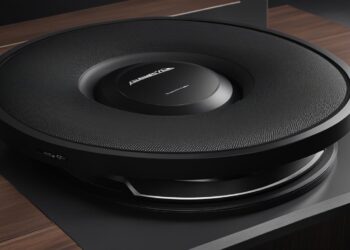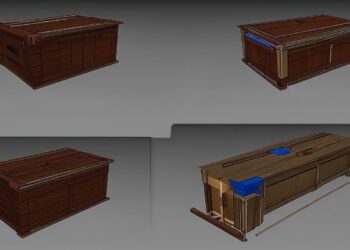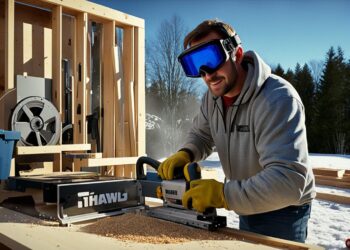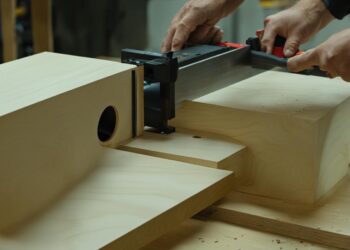Welcome to the ultimate DIY guide on how to make a ported 15-inch subwoofer box! Are you tired of searching for the perfect subwoofer box that matches your specifications? Do you want to enhance the audio quality of your car or home audio system? Look no further. In this comprehensive guide, I will walk you through the step-by-step process of designing and building your own ported 15-inch subwoofer box. Get ready to unleash powerful bass and take your audio experience to the next level.
But before we dive in, let me ask you this: Do you believe that building a custom subwoofer box is a complex task that only professionals can accomplish? Well, prepare to be surprised. With the right knowledge and tools at your disposal, constructing a ported subwoofer box is an achievable DIY project for any audio enthusiast. Let’s challenge the notion that you need to rely on pre-made boxes and discover the satisfaction of creating your very own customized subwoofer enclosure.
Key Takeaways:
- Building a ported 15-inch subwoofer box is a DIY project that can be accomplished with the right knowledge and tools.
- Creating a custom subwoofer box allows you to customize the look, fit, and audio quality of your system.
- In this guide, we will provide step-by-step instructions on designing and constructing a ported subwoofer box.
- You don’t have to be a professional to achieve powerful bass and enhance your audio experience.
- Let’s challenge the notion that building a subwoofer box is complex and discover the satisfaction of creating your own enclosure.
Selecting the Right Enclosure for Your Subwoofer
Before building a subwoofer box, it is important to understand the different types of enclosures and how they affect sound performance. Considerations such as available space, speaker compatibility, amplifier power, and music preferences will determine the most suitable enclosure type. The three main enclosure types discussed here are the infinite baffle, sealed enclosure, and ported enclosure.
The infinite baffle is a simple and space-saving design that utilizes the vehicle’s trunk space or rear package tray as the enclosure. It offers overall sound quality but requires a woofer designed for infinite baffle or ported enclosures. Careful sealing of the mounting baffle is also necessary to prevent sound cancellation.
The sealed enclosure, also known as an acoustic suspension enclosure, provides accurate bass reproduction and tight bass response. The size of the enclosure and power handling capabilities impact the bass output and performance. Smaller sealed enclosures are suitable for genres like rock, while larger ones offer lower bass response.
The ported enclosure, also called a bass reflex enclosure, uses a tuning port or vent to enhance bass output at specific frequencies. It can provide increased output levels and maximize subwoofer performance, even with lower-power amplifiers. However, designing and constructing a ported enclosure requires adherence to manufacturer specifications for optimal tuning, power handling, and prevention of bass roll-off.
To visually illustrate the differences between these enclosure types, refer to the table below:
| Enclosure Type | Sound Performance | Space Requirements | Bass Response |
|---|---|---|---|
| Infinite Baffle | Overall sound quality, potential for cancellation if not sealed properly | Minimal space required | Depends on woofer design |
| Sealed Enclosure | Accurate bass reproduction, tight bass response | Varies based on enclosure size | Depends on enclosure size |
| Ported Enclosure | Increased output at specific frequencies, potential for bass roll-off | Varies based on enclosure size and tuning requirements | Depends on enclosure size and tuning |
Understanding the characteristics and differences between these enclosure types will help you make an informed decision when selecting the right enclosure for your subwoofer.
Exploring the Benefits and Limitations of Infinite Baffle Enclosures
An infinite baffle is a simple type of enclosure that utilizes the vehicle’s trunk space or rear package tray as the “enclosure.” This mounting method is known for its overall sound quality and space-saving benefits. However, it requires a woofer designed specifically for infinite baffle or ported enclosures and careful sealing of the mounting baffle to prevent sound cancellation.
The characteristics of an infinite baffle mounting provide unique advantages for subwoofer performance. The absence of an enclosed space allows the woofer to produce clean, undistorted bass frequencies. The large volume of the trunk acts as the enclosure, resulting in a more natural and extended low-frequency response.
When properly implemented, infinite baffle enclosures can deliver exceptional bass reproduction and a smooth frequency response. The lack of an enclosure also eliminates the resonances and box colorations that may occur in other enclosure types.
However, it is essential to consider the limitations of infinite baffle mounting. Due to the lack of enclosure confinement, infinite baffle setups may have lower power handling capabilities compared to other enclosure types. The total output of the subwoofer may also be limited due to the open-air environment.
Building an infinite baffle enclosure requires attention to detail. One must ensure the mounting baffle is meticulously sealed to prevent air leaks, as they can degrade the overall performance and potentially result in sound cancellation.
Additionally, selecting a woofer designed specifically for infinite baffle or ported enclosures is crucial for optimal performance. These woofers are designed to work efficiently in open-air environments and deliver the desired low-frequency response.
By considering these factors and choosing the appropriate woofer, infinite baffle mounting can provide an excellent solution for individuals seeking high-quality sound reproduction while making efficient use of available space in their vehicles.

Continue reading to learn more about sealed and ported enclosures and their characteristics.
Understanding the Characteristics of Sealed Enclosures
Sealed enclosures, also known as acoustic suspension enclosures, are a popular choice for subwoofer enthusiasts seeking accurate bass reproduction and a tight bass response. These enclosures are designed to minimize air leakage, resulting in improved control over the subwoofer’s movement and ultimately delivering precise and impactful bass performance.
When it comes to sealed enclosure design, the size of the enclosure and its power handling capabilities play a crucial role in determining the bass output and overall performance. Smaller sealed enclosures are ideal for genres like rock and hard rock, where a punchy and controlled bass response is desired. On the other hand, larger sealed enclosures offer a deeper bass response, making them suitable for genres that demand a more pronounced low-end, such as electronic music or hip-hop.
The frequency response of a sealed enclosure is relatively flat, providing a balanced reproduction of low-frequency sounds. This characteristic ensures that the bass output remains controlled and accurate across the entire frequency range. Additionally, the sealed design prevents unwanted resonance and phase cancellations, which can negatively impact the overall sound quality.
Here is a visualization of the frequency response of a sealed enclosure:
As depicted in the graph, the roll-off rate of bass in a sealed enclosure is 12 dB/octave. This means that the bass response gradually decreases as the frequency decreases below the enclosure’s designed cutoff point. The roll-off rate of 12 dB/octave contributes to a smoother transition between the subwoofer and other speakers in the system, creating a seamless and harmonious audio experience.
Advantages of Sealed Enclosures:
- Accurate and precise bass reproduction
- Tight and controlled bass response
- Flat and balanced frequency response
- Eliminates resonance and phase cancellations
Disadvantages of Sealed Enclosures:
- Less efficient compared to ported enclosures
- Require more amplifier power to achieve high output levels
- Large sealed enclosures may occupy more space
- May not provide the same “boom” or “impact” as ported enclosures
In conclusion, sealed enclosures excel in delivering accurate bass reproduction and a tight bass response. Their design minimizes resonance and phase cancellations, resulting in a balanced and controlled bass performance. However, it’s important to consider the trade-offs, such as reduced efficiency and potentially larger enclosure size in some cases.
Maximizing Bass Output with Ported Enclosures
Ported enclosures, also known as bass reflex enclosures, are designed to enhance the bass output of subwoofers at specific frequencies. These enclosures utilize a tuning port or vent to optimize the performance and deliver increased output levels. Even with lower-power amplifiers, ported enclosures can maximize the bass performance, making them a popular choice among audio enthusiasts.
When designing and constructing a ported enclosure, it is important to follow the manufacturer’s specifications for optimal tuning and power handling. This ensures that the enclosure is properly aligned with the subwoofer’s characteristics, resulting in enhanced bass response and minimized roll-off.
Compared to sealed and infinite baffle enclosures, ported enclosures have a roll-off rate of 24 dB/octave. This means that the low-frequency output gradually decreases beyond the tuning frequency, providing a smoother transition and more controlled bass response. However, it is important to note that ported enclosures may exhibit more group delay and require larger physical dimensions to accommodate the tuning port.
By carefully designing and constructing a ported enclosure, it is possible to achieve increased bass output at specific frequencies, delivering a more impactful and immersive audio experience. The proper combination of subwoofer, enclosure design, and tuning can result in powerful low-frequency reproduction that complements your music genre and personal preferences.
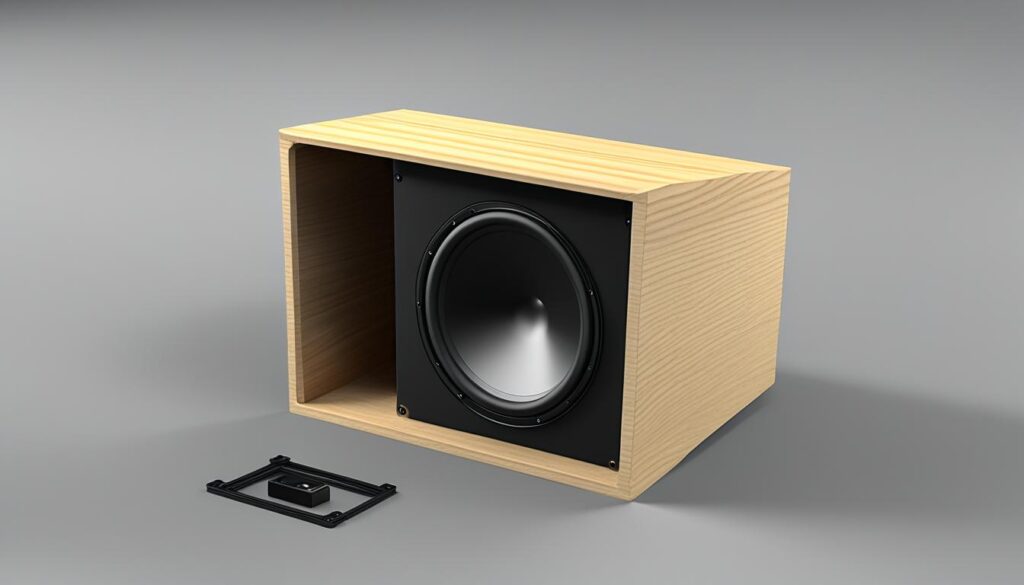
| Enclosure Type | Roll-Off Rate | Size and Dimensions | Bass Response |
|---|---|---|---|
| Ported Enclosure | 24 dB/octave | Larger dimensions due to tuning port | Enhanced at specific frequencies |
| Sealed Enclosure | 12 dB/octave | Compact | Tight and accurate |
| Infinite Baffle Enclosure | Depends on mounting area and baffle design | Utilizes vehicle trunk or rear package tray | Overall sound quality |
Step-by-Step Guide to Building a Ported 15-Inch Subwoofer Box
Building a ported 15-inch subwoofer box can greatly enhance the bass performance of your audio system. This step-by-step guide will walk you through the process of designing and constructing the box, ensuring optimal dimensions and efficient assembly. With the right tools and materials, you’ll be able to create a custom subwoofer box that delivers powerful and precise bass reproduction.
Gather the Necessary Tools and Materials
Before you begin building your subwoofer box, make sure you have the following tools and materials:
- MDF (Medium Density Fiberboard) panels
- Tape measure
- Circular saw or table saw
- Jigsaw
- Drill and drill bits
- Screwdriver
- Screws or wood glue
- Subwoofer mounting hardware
- Speaker wire
- Terminal cup
Determine the Dimensions of the Box
The dimensions of your subwoofer box are crucial for achieving optimal bass response. To determine the dimensions, you can use a subwoofer box calculator or follow general guidelines based on the specifications of your subwoofer. Consider the recommended internal volume, port size, and port length for your specific subwoofer model.
Once you have the dimensions, mark and measure the MDF panels accordingly. Make sure to leave extra space for the thickness of the panels when calculating the dimensions.
Cut and Assemble the Box
Using a circular saw or table saw, carefully cut the MDF panels according to the measured dimensions. Ensure clean and accurate cuts to ensure a snug and stable fit.
Next, assemble the box by attaching the panels together using screws or wood glue. Apply the glue evenly along the edges for a strong bond. Use a clamp or heavy objects to hold the panels in place while the glue sets.
Create the Port
A ported subwoofer box requires a tuning port or vent to enhance bass output. The port length and diameter should be determined based on the specifications of your subwoofer and desired tuning frequency. You can use an online port calculator or follow manufacturer guidelines for optimal port design.
Using a jigsaw, carefully cut the port hole in one of the MDF panels. Install the port securely and seal any gaps with silicone or adhesive foam to prevent air leaks.
Install the Subwoofer and Wiring
Once the box is assembled and the port is in place, it’s time to install the subwoofer. Attach the subwoofer mounting hardware to the box, ensuring a secure fit. Connect the subwoofer to the amplifier using high-quality speaker wire, and route the wire through a terminal cup for a clean and professional-looking installation.
Test and Fine-Tune
After completing the construction and wiring, connect your subwoofer box to the amplifier and test the sound output. Adjust the positioning of the box and experiment with different placement options to achieve the desired bass response. Fine-tune the settings on your amplifier to optimize the performance of your subwoofer box.
Summary
Building a ported 15-inch subwoofer box requires careful consideration of dimensions and precise construction techniques. By following this step-by-step guide and utilizing the right tools, materials, and expertise, you can create a custom subwoofer box that enhances the bass performance of your audio system. Enjoy deep and resonating bass with your DIY ported subwoofer box.
Final Thoughts on Building a Ported Subwoofer Box
Building a custom subwoofer box is an exciting project that allows you to tailor your audio system to your preferences. By following this comprehensive subwoofer box building guide, you can create a ported 15-inch subwoofer box that delivers deep, resonating bass.
It is essential to understand the different enclosure types and their characteristics to make an informed decision. Whether you opt for the space-saving benefits of an infinite baffle enclosure, the accurate bass reproduction of a sealed enclosure, or the increased output capabilities of a ported enclosure, there is a solution for your needs.
By carefully following the step-by-step instructions provided in this guide and considering the essential tips shared, you can successfully construct a custom subwoofer box. This will not only enhance the overall audio experience but also add a touch of personalization to your car audio system. So, put your DIY skills to the test and enjoy the satisfaction of building a custom subwoofer box that delivers impressive bass performance.
FAQ
What are the benefits of building a ported subwoofer box?
Building a ported subwoofer box allows for increased bass output at specific frequencies and maximizes the performance of the subwoofer, even with lower-power amplifiers.
How do I select the right enclosure for my subwoofer?
When selecting an enclosure, consider factors such as available space, speaker compatibility, amplifier power, and your music preferences. The three main enclosure types to consider are the infinite baffle, sealed enclosure, and ported enclosure.
What are the benefits and limitations of infinite baffle enclosures?
Infinite baffle enclosures utilize the vehicle’s trunk space or rear package tray as the “enclosure,” offering overall sound quality and space-saving benefits. However, they require a woofer designed for infinite baffle or ported enclosures and careful sealing of the mounting baffle to prevent sound cancellation.
What are the characteristics of sealed enclosures?
Sealed enclosures, also known as acoustic suspension enclosures, provide accurate bass reproduction and tight bass response. The size of the enclosure and power handling capabilities impact the bass output and performance.
How can I maximize bass output with ported enclosures?
Ported enclosures, also called bass reflex enclosures, utilize a tuning port or vent to enhance bass output at specific frequencies. They can provide increased output levels and maximize the performance of a subwoofer, even with lower-power amplifiers.
What is the process for building a ported 15-inch subwoofer box?
To build a ported 15-inch subwoofer box, you will need to determine the correct dimensions, cut the MDF panels, assemble the box, and install the subwoofer. Follow our step-by-step guide for detailed instructions.
What are some tips for building a successful subwoofer box?
Some essential tips for building a successful subwoofer box include using the correct dimensions, ensuring airtight construction, considering internal bracing, and sanding and sealing the box for a professional finish. Proper handling and installation of the subwoofer are also crucial.
How does building a custom subwoofer box enhance my audio experience?
Building a custom subwoofer box allows for customization in terms of look, fit, and audio performance. By selecting the right enclosure type and dimensions, you can achieve deep, resonating bass that enhances the overall audio experience of your system.






